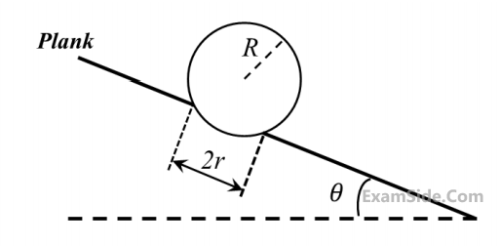


A wire, which passes through the hole in a small bead, is bent in the form of quarter of a circle. The wire is fixed vertically on ground as shown in the below figure. The bead is released from near the top of the wire and it slides along the wire without friction. As the bead moves from A to B, the force it applies on the wire is

A block of mass m1 = 1 kg another mass m2 = 2 kg, are placed together (see figure) on an inclined plane with angle of inclination $$\theta$$. Various values of $$\theta$$ are given in List I. The coefficient of friction between the block m1 and the plane is always zero. The coefficient of static and dynamic friction between the block m2 and the plane are equal to $$\mu$$ = 0.3. In List II expressions for the friction on the block m2 are given. Match the correct expression of the friction in List II with the angles given in List I, and choose the correct option. The acceleration due to gravity is denoted by g.
[Useful information : tan (5.5$$^\circ$$) $$\approx$$ 0.1; tan (11.5$$^\circ$$) $$\approx$$ 0.2; tan (16.5$$^\circ$$) $$\approx$$ 0.3]

| List I | List II | ||
|---|---|---|---|
| P. | $$\theta = 5^\circ $$ |
1. | $${m_2}g\sin \theta $$ |
| Q. | $$\theta = 10^\circ $$ |
2. | $$({m_1} + {m_2})g\sin \theta $$ |
| R. | $$\theta = 15^\circ $$ |
3. | $$\mu {m_2}g\cos \theta $$ |
| S. | $$\theta = 20^\circ $$ |
4. | $$\mu ({m_1} + {m_2})g\cos \theta $$ |